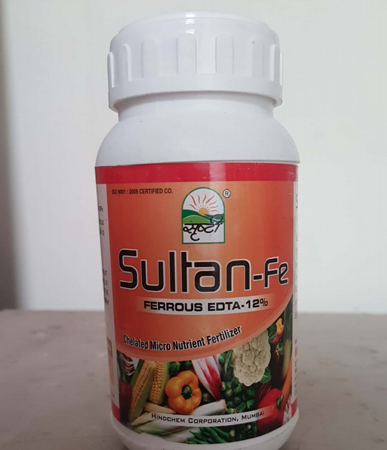
Iron deficiency is a Limiting factor of plant growth.iron is present at high quantities in soils,but its availability to plants is usually very low ,and therefore iron deficiency is a common problem.
IRON AVAILABILITY TO PLANTS- Although most of the iron on the earth crust is in the form of Fe3+,the Fe2+ form is physiologically more significant for plants.This form is relatively soluble,but is readily oxidized to fe3+,which then precipitates.
Fe3+ is insoluble in neutral and high pH,making iron unavailable to plants in alkaline and in calcareous soils,
Furthermore,in these types of soil,iron readily combines with phosphates, carbonates,calcium,magnesium and hydroxide ions.In such types of soils it is recommended to use iron chelates
Iron Uptake by Plants
Plants uptake iron in its oxidized forms Fe2(ferrous form) or Fe3+(ferric form) Plants use various iron uptake mechanisms. One of these is the chelation mechanism the plant releases compounds called siderophores which bind iron and enhance its solubility. This mechanism also involves bacteria. Another mechanism involves the release of protons(H+)and reductants by the plant roots, to lower Ph levels in root zone .The result is increased iron solubility. In this respect ,choice of the form of nitrogen fertilizer is significant.
Ammonium nitrogen increases proton release by roots ,thus lowering Ph and facilitating iron uptake.
Nitrate nitrogen enhances the release of hydroxide ions that increase pH in the root zone and counteract efficient iron uptake
New roots and root hairs are more active in iron uptake,therefore it is imperative to maintain a healthy active root system .Any factor interfering with root development interfering with iron uptake
Manufacturing
- Roots Gold (Mycorrhizae)
- Pota Rise (Mycorrhizae)
- Maagnet PROM (Phosphate Rich Organic Manure)
- NPK 19.19.19
- NPK 13.00.45
- NPK 12.61.00
- NPK 00.52.34 Mono Potassium Phosphate
- 00.00.50 Sulphate of Patash
- Calcium Nitrate: N15.5%, CA18.8%
- Phose Up
- Liquid Zinc
- FERROUS EDTA
- Lemon Zinc 12%
- BORON
- MAGKARANTI
- IRON
- SUPER FIX
- S SARDAR G
- S SARDAR-G LIQUID
- BLACK DIAMOND 98
- FUTARA
- JAVA PREMIUM
- LIQUID POTASH